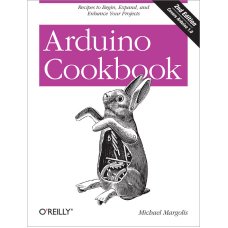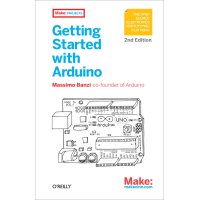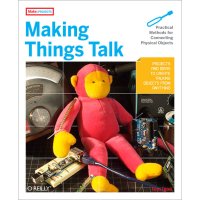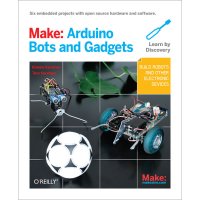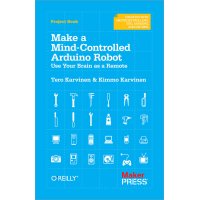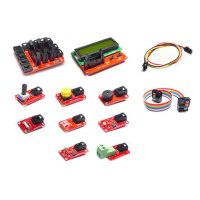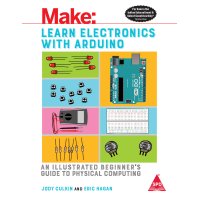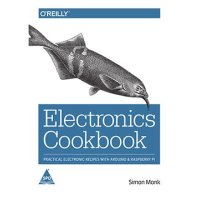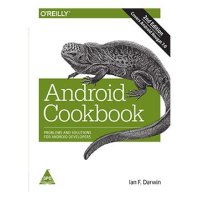Want to create devices that interact with the physical world? This cookbook is perfect for anyone who wants to experiment with the popular Arduino microcontroller and programming environment. You’ll find more than 200 tips and techniques for building a variety of objects and prototypes such as toys, detectors, robots, and interactive clothing that can sense and respond to touch, sound, position, heat, and light. You don’t need experience with Arduino or programming to get started. Updated for the Arduino 1.0 release, the recipes in this second edition include practical examples and guidance to help you begin, expand, and enhance your projects right away-whether you’re an artist, designer, hobbyist, student, or engineer.
- Get up to speed on the Arduino board and essential software concepts quickly
- Learn basic techniques for reading digital and analog signals
- Use Arduino with a variety of popular input devices and sensors
- Drive visual displays, generate sound, and control several types of motors
- Interact with devices that use remote controls, including TVs and appliances
- Learn techniques for handling time delays and time measurement
- Apply advanced coding and memory handling techniques
About the Author
Michael Margolis is a technologist in the field of real time computing with expertise in developing and delivering hardware and software for interacting with the environment. He has more than 30 years of experience at senior levels with Sony, Microsoft, and Lucent/Bell Labs. He has written libraries and core software that are part of the official Arduino 1.0 distribution.
Table of Contents
Chapter 1 Getting Started
- Introduction
- Installing the Integrated Development Environment (IDE)
- Setting Up the Arduino Board
- Using the Integrated Development Environment (IDE) to Prepare an Arduino Sketch
- Uploading and Running the Blink Sketch
- Creating and Saving a Sketch
- Using Arduino
Chapter 2 Making the Sketch Do Your Bidding
- Introduction
- Structuring an Arduino Program
- Using Simple Primitive Types (Variables)
- Using Floating-Point Numbers
- Working with Groups of Values
- Using Arduino String Functionality
- Using C Character Strings
- Splitting Comma-Separated Text into Groups
- Converting a Number to a String
- Converting a String to a Number
- Structuring Your Code into Functional Blocks
- Returning More Than One Value from a Function
- Taking Actions Based on Conditions
- Repeating a Sequence of Statements
- Repeating Statements with a Counter
- Breaking Out of Loops
- Taking a Variety of Actions Based on a Single Variable
- Comparing Character and Numeric Values
- Comparing Strings
- Performing Logical Comparisons
- Performing Bitwise Operations
- Combining Operations and Assignment
Chapter 3 Using Mathematical Operators
- Introduction
- Adding, Subtracting, Multiplying, and Dividing
- Incrementing and Decrementing Values
- Finding the Remainder After Dividing Two Values
- Determining the Absolute Value
- Constraining a Number to a Range of Values
- Finding the Minimum or Maximum of Some Values
- Raising a Number to a Power
- Taking the Square Root
- Rounding Floating-Point Numbers Up and Down
- Using Trigonometric Functions
- Generating Random Numbers
- Setting and Reading Bits
- Shifting Bits
- Extracting High and Low Bytes in an int or long
- Forming an int or long from High and Low Bytes
Chapter 4 Serial Communications
- Introduction
- Sending Debug Information from Arduino to Your Computer
- Sending Formatted Text and Numeric Data from Arduino
- Receiving Serial Data in Arduino
- Sending Multiple Text Fields from Arduino in a Single Message
- Receiving Multiple Text Fields in a Single Message in Arduino
- Sending Binary Data from Arduino
- Receiving Binary Data from Arduino on a Computer
- Sending Binary Values from Processing to Arduino
- Sending the Value of Multiple Arduino Pins
- How to Move the Mouse Cursor on a PC or Mac
- Controlling Google Earth Using Arduino
- Logging Arduino Data to a File on Your Computer
- Sending Data to Two Serial Devices at the Same Time
- Receiving Serial Data from Two Devices at the Same Time
- Setting Up Processing on Your Computer to Send and Receive Serial Data
Chapter 5 Simple Digital and Analog Input
- Introduction
- Using a Switch
- Using a Switch Without External Resistors
- Reliably Detecting the Closing of a Switch
- Determining How Long a Switch Is Pressed
- Reading a Keypad
- Reading Analog Values
- Changing the Range of Values
- Reading More Than Six Analog Inputs
- Displaying Voltages Up to 5V
- Responding to Changes in Voltage
- Measuring Voltages More Than 5V (Voltage Dividers)
Chapter 6 Getting Input from Sensors
- Introduction
- Detecting Movement
- Detecting Light
- Detecting Motion (Integrating Passive Infrared Detectors)
- Measuring Distance
- Measuring Distance Accurately
- Detecting Vibration
- Detecting Sound
- Measuring Temperature
- Reading RFID Tags
- Tracking Rotary Movement
- Tracking the Movement of More Than One Rotary Encoder
- Tracking Rotary Movement in a Busy Sketch
- Using a Mouse
- Getting Location from a GPS
- Detecting Rotation Using a Gyroscope
- Detecting Direction
- Getting Input from a Game Control Pad (PlayStation)
- Reading Acceleration
Chapter 7 Visual Output
- Introduction
- Connecting and Using LEDs
- Adjusting the Brightness of an LED
- Driving High-Power LEDs
- Adjusting the Color of an LED
- Sequencing Multiple LEDs: Creating a Bar Graph
- Sequencing Multiple LEDs: Making a Chase Sequence (Knight Rider)
- Controlling an LED Matrix Using Multiplexing
- Displaying Images on an LED Matrix
- Controlling a Matrix of LEDs: Charlieplexing
- Driving a 7-Segment LED Display
- Driving Multidigit, 7-Segment LED Displays: Multiplexing
- Driving Multidigit, 7-Segment LED Displays Using MAX7221 Shift Registers
- Controlling an Array of LEDs by Using MAX72xx Shift Registers
- Increasing the Number of Analog Outputs Using PWM Extender Chips (TLC5940)
- Using an Analog Panel Meter as a Display
Chapter 8 Physical Output
- Introduction
- Controlling the Position of a Servo
- Controlling One or Two Servos with a Potentiometer or Sensor
- Controlling the Speed of Continuous Rotation Servos
- Controlling Servos Using Computer Commands
- Driving a Brushless Motor (Using a Hobby Speed Controller)
- Controlling Solenoids and Relays
- Making an Object Vibrate
- Driving a Brushed Motor Using a Transistor
- Controlling the Direction of a Brushed Motor with an H-Bridge
- Controlling the Direction and Speed of a Brushed Motor with an H-Bridge
- Using Sensors to Control the Direction and Speed of Brushed Motors (L293 H-Bridge)
- Driving a Bipolar Stepper Motor
- Driving a Bipolar Stepper Motor (Using the EasyDriver Board)
- Driving a Unipolar Stepper Motor (ULN2003A)
Chapter 9 Audio Output
- Introduction
- Playing Tones
- Playing a Simple Melody
- Generating More Than One Simultaneous Tone
- Generating Audio Tones and Fading an LED
- Playing a WAV File
- Controlling MIDI
- Making an Audio Synthesizer
Chapter 10 Remotely Controlling External Devices
- Introduction
- Responding to an Infrared Remote Control
- Decoding Infrared Remote Control Signals
- Imitating Remote Control Signals
- Controlling a Digital Camera
- Controlling AC Devices by Hacking a Remote-Controlled Switch
Chapter 11 Using Displays
- Introduction
- Connecting and Using a Text LCD Display
- Formatting Text
- Turning the Cursor and Display On or Off
- Scrolling Text
- Displaying Special Symbols
- Creating Custom Characters
- Displaying Symbols Larger Than a Single Character
- Displaying Pixels Smaller Than a Single Character
- Connecting and Using a Graphical LCD Display
- Creating Bitmaps for Use with a Graphical Display
- Displaying Text on a TV
Chapter 12 Using Time and Dates
- Introduction
- Creating Delays
- Using millis to Determine Duration
- More Precisely Measuring the Duration of a Pulse
- Using Arduino as a Clock
- Creating an Alarm to Periodically Call a Function
- Using a Real-Time Clock
Chapter 13 Communicating Using I2C and SPI
- Introduction
- Controlling an RGB LED Using the BlinkM Module
- Using the Wii Nunchuck Accelerometer
- Interfacing to an External Real-Time Clock
- Adding External EEPROM Memory
- Reading Temperature with a Digital Thermometer
- Driving Four 7-Segment LEDs Using Only Two Wires
- Integrating an I2C Port Expander
- Driving Multidigit, 7-Segment Displays Using SPI
- Communicating Between Two or More Arduino Boards
Chapter 14 Wireless Communication
- Introduction
- Sending Messages Using Low-Cost Wireless Modules
- Connecting Arduino to a ZigBee or 802.15.4 Network
- Sending a Message to a Particular XBee
- Sending Sensor Data Between XBees
- Activating an Actuator Connected to an XBee
- Sending Messages Using Low-Cost Transceivers
- Communicating with Bluetooth Devices
Chapter 15 Ethernet and Networking
- Introduction
- Setting Up the Ethernet Shield
- Obtaining Your IP Address Automatically
- Resolving Hostnames to IP Addresses (DNS)
- Requesting Data from a Web Server
- Requesting Data from a Web Server Using XML
- Setting Up an Arduino to Be a Web Server
- Handling Incoming Web Requests
- Handling Incoming Requests for Specific Pages
- Using HTML to Format Web Server Responses
- Serving Web Pages Using Forms (POST)
- Serving Web Pages Containing Large Amounts of Data
- Sending Twitter Messages
- Sending and Receiving Simple Messages (UDP)
- Getting the Time from an Internet Time Server
- Monitoring Pachube Feeds
- Sending Information to Pachube
Chapter 16 Using, Modifying, and Creating Libraries
- Introduction
- Using the Built-in Libraries
- Installing Third-Party Libraries
- Modifying a Library
- Creating Your Own Library
- Creating a Library That Uses Other Libraries
- Updating Third-Party Libraries for Arduino 1.0
Chapter 17 Advanced Coding and Memory Handling
- Introduction
- Understanding the Arduino Build Process
- Determining the Amount of Free and Used RAM
- Storing and Retrieving Numeric Values in Program Memory
- Storing and Retrieving Strings in Program Memory
- Using #define and const Instead of Integers
- Using Conditional Compilations
Arduino Cookbook 2nd Ed
- Brand: O'reilley
- Product Code: Bok-Ard-Cuk-2ed
- Reward Points: 11
- Availability: In Stock
-
रo 1,075.00
- Price in reward points: 1075
Related Products
Getting Started With Arduino 3rd Edition
Authored by Massimo Banzi , one of the co-creators of Arduino. This particular edition gives you..
रo 425.00
Making Things Talk: Practical Methods for Connecting Physical Objects
This book contains a series of projects that teaches readers what they need to know to get their cre..
रo 900.00
Make: Arduino Bots and Gadgets
Want to build your own robots, turn your ideas into prototypes, control devices with a com..
रo 650.00
Make a Mind-Controlled Arduino Robot
Build a robot that responds to electrical activity in your brain—it’s easy and fun. If you’re famili..
रo 225.00
Electronic Brick - Starter Kit
This is a Starter kit of electronic brick; it includes basic components and sensors. You can build m..
रo 6,464.00 रo 6,895.00
Learn Electronics With Arduino - Jody Culkin And Eric Hagan
All Indian Reprints of Maker Media are printed in Grayscale. This book is your introductio..
रo 750.00
Electronics Cookbook - Simon Monk
If you’re among the many hobbyists and designers who came to electronics through Arduino and Raspber..
रo 1,200.00
Android Cookbook - 2nd Edition
With Early Release ebooks, you get books in their earliest form—the author's raw and unedited conten..
रo 1,800.00

